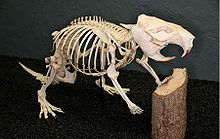DENTAL FORMULA

[Photo credit: Dozenist]
Dental formula can be defined as the number and types of teeth an animal has in one half of each jaw. Different mammals have different dental formulae depending on their diet. In the following formulae:

[Photo credit: Dozenist]
Dental formula can be defined as the number and types of teeth an animal has in one half of each jaw. Different mammals have different dental formulae depending on their diet. In the following formulae:

























